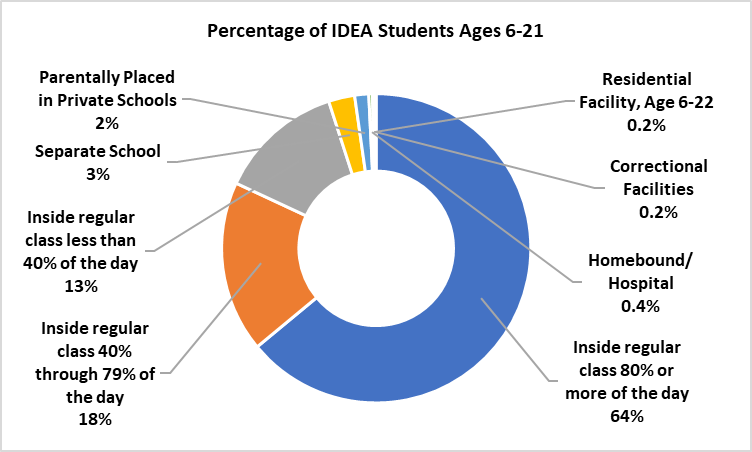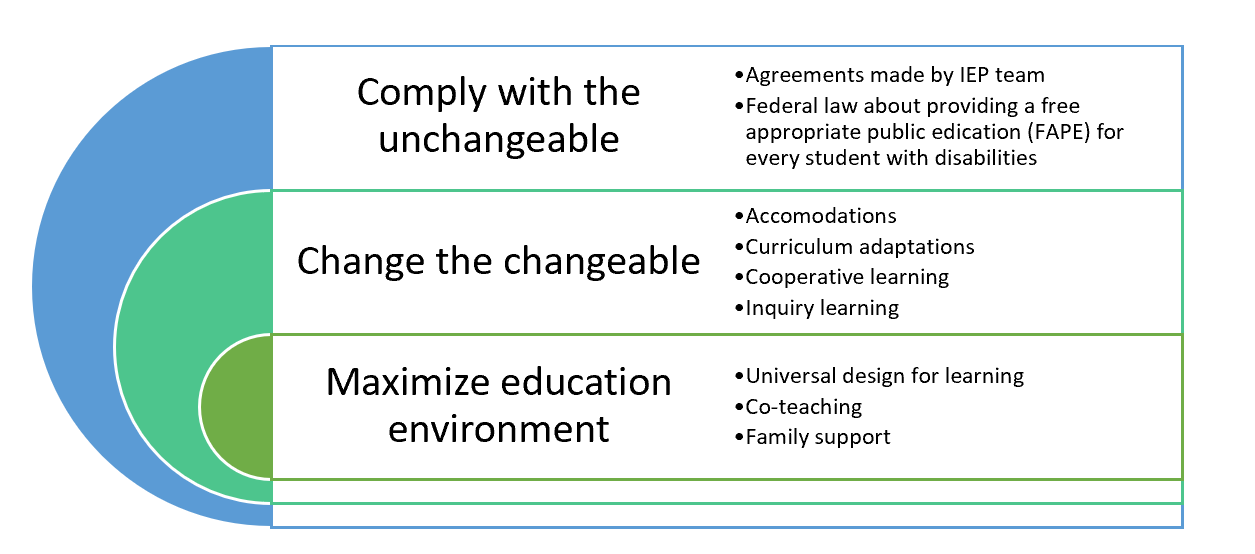Worldwide, roughly 9 out of 10 students are out of school, according to the United Nations Educational, Scientific and Cultural Organization (UNESCO). In the United States, the school closures caused by the coronavirus pandemic affect more than 50 million students, including 7 million students ages 3–21 who receive special education services under the Individuals with Disabilities Education Act (IDEA). With prolonged school closures, school districts are faced with more challenges about how to provide remote learning for students served under IDEA while complying with civil rights and disability laws.
Education environment, namely where students with disabilities are served and educated, is an important component in the student’s “individualized education program” (IEP). As online learning opportunities continue to expand particularly during the recent school closures, educators may need to reexamine each student’s IEP, work with parents and families, determine whether students with disabilities can access and progress in the online curriculum, and figure out best approaches and long-term strategies to continue their special education. The continuing digital divide that some students face, commonly called the homework gap, only adds to the difficulty.
Where do students with disabilities usually receive their education services?
By increasing awareness of where students with IEPs receive their instruction, school leaders can work with teachers to make evidence-based policies and develop effective strategies to support the learning of each student with disabilities. According to data from the U.S. Department of Education:
- Among 815,000 students ages 3-5 served under IDEA,
- 40% attend at least 10 hours per week in a regular early childhood program;
- 22% attend separate classes; and
- 17% attend at least 10 hours per week in locations other than a regular early childhood program.
- Among 6.32 million students ages 6-21 served under IDEA (Figure 1),
- 64% are served inside a regular classroom in a brick and mortar school 80% or more of the time during a typical school day; and
- 18%, inside a regular classroom 40-79% of the day.
Figure 1. Percentage of Students with IEPs Ages 6-21, by SEA Education Environment: 2018

Note: Percentages may not total 100 due to rounding;
Source: https://www2.ed.gov/programs/osepidea/618-data/state-level-data-files/index.html
Under IDEA, there are 13 disability categories. More than one third of students with IEPs ages 6-21 are served under the category “specific learning disability” (i.e. a disorder in one or more of the basic psychological processes involved in understanding or in using language, spoken or written, that may manifest itself in the imperfect ability to listen, think, speak, read, write, spell, or to do mathematical calculations, including conditions such as perceptual disabilities, brain injury, minimal brain dysfunction, dyslexia, and developmental aphasia).
Among students with IEPs in a regular classroom 80% or more of the day:
- 43% are students with specific learning disability; and
- 23% are students with speech or language impairment.
In contrast, among students with IEPs in a regular classroom less than 40% of the day:
- 27% are students with autism;
- 25% are students with intellectual disability; and
- 13% are students with specific learning disability.
Most students with IEPs are served in the inclusive classroom in public schools and many of them are students with different learning disabilities. For public school leaders, every student with disabilities matters. Many state education agencies, such as the California Department of Education, acknowledge the complex, unprecedented challenges schools are experiencing in terms of COVID-19 school closures and services to students with disabilities. The data suggest that it is a challenging process to maximize the education environment to provide each student with the most appropriate learning opportunities, particularly under the extraordinary situations brought about by the school closures as a result of the pandemic.
How can schools maximize the education environment for students with IEPs?
Maximizing the education environment means to provide rich learning experiences for each student based on the relevant conditions and circumstances. Some experts suggest that special education teachers not only need to adapt to a new virtual reality, but also need to make sure lessons connect to real life and “lean into the tools and objects students have in the home.” For example, if students use blocks for counting in the classroom, they may use something like pasta to learn counting at home; for a lesson about surface area, students may count how many tiles are in the kitchen, or how many steps it takes to get from one side of the room to the other.
The U.S. Department of Education recently emphasized that ensuring compliance with federal laws should not prevent any school from offering educational programs through distance instruction. The challenge school leaders are facing is how to continue the personalized approach for students with IEPs through digital learning and instruction. To support school leaders’ efforts to maximize the education environment for these students, the NSBA Center for Public Education (CPE) proposes a three-element model (Figure 2) based on a review of the relevant data and research.
Figure 2. Three-element Model to Maximize The Education Environment for Students with IEPs

In the model, the core element is to maximize the education environment for every student served under IDEA. To attain this goal, school leaders may consider the following approaches:
- Universal design for learning (UDL) - a framework to improve and optimize teaching and learning for all students - includes methods and materials that are flexible and powerful to help all students, regardless of their ability, to maximize their progress.
- Co-teaching - “the collaboration between general and special education teachers for all of the teaching responsibilities of all students assigned to a classroom” (Gately & Gately, 2001) - creates opportunities for teachers and specialists to connect, communicate, and collaborate in facilitating the instructional modifications/ accommodations required for student success and implementing personalized learning enhanced by technology.
- Family support is essential in remote learning. Schools and educators should create efficient communication and effective partnerships with families of students with disabilities. For students with disabilities who are unable to participate in online instruction, schools should establish a good rapport with students and families, solve issues collaboratively, and work out education plans together.
As the overarching objective is to maximize students’ learning environments, the next step for school leaders is to identify what components can be changed in students’ IEPs. When educators plan for digital instruction provided primarily online, they may consider accommodating students with different disabilities, adapting curriculum for students served under IDEA in their class, and making learning truly personalized.
- Accommodations are specific teaching techniques used by teachers in their instruction, such as audio or other formats as an alternative to print, technology, graphic organizers, and pictorial representation. Additionally, teachers may change the amount of input, timeframe for learning, and levels of support for individual students' needs. School leaders should work closely with teachers by providing the support needed to accommodate students with IEPs.
- Curriculum adaptations refers to changes made to what is expected of the student, the way the course is taught, and the tools used to teach the course. Examples of the approaches are (a) shortening or simplifying an assignment (e.g., giving students with disabilities more time to complete assignments), (b) giving students with disabilities opportunities to speak or use dictation instead of writing out long assignments, and (c) providing audio materials for reading assignments.
- Cooperative learning is an instructional strategy in which a small group of students work together to accomplish a specified learning task. With the help of technology, students with IEPs, including students with severe disabilities, can develop social interaction skills in the general education settings enhanced by technology.
- Inquiry learning, or project-based learning, is another instructional strategy to develop students’ real-life skills. Inquiry learning requires students individually or collectively to complete a project or solve a problem by doing research and analyzing information. Research shows that students with disabilities can learn more in such an open environment. As a type of personalized learning, the strategy allows students to perform tasks they are good at, enhances student self-esteem, and encourages constructive social interaction. Teachers play a critical role in this instructional approach, for both special and general education teachers need to create and present a project and provide appropriate background information for students to solve problems.
Schools need to comply with federal civil rights laws and implement best practices for the continuity of special education. We suggest that school districts look at their data about students with IEPs and determine which parts of the education environment are changeable and which are not. Then, work with families and teachers to assess/update each student’s IEP and carry out the personalized learning plan due to school closures.
In summary, teachers, specialists, parents and families all play critical roles in the successful continuation of education for students with disabilities during unplanned school closures. Knowing how/where students with disabilities usually receive their education services can help school leaders make sound policies to ensure that every student’s learning keeps progressing.
* Although this blog article focuses on data and research for students with disabilities served under IDEA, many of the concepts could be applied to students served under Section 504 of the Rehabilitation Act of 1974, 29 USC §794; 34 CFR Part 104.

Share this content